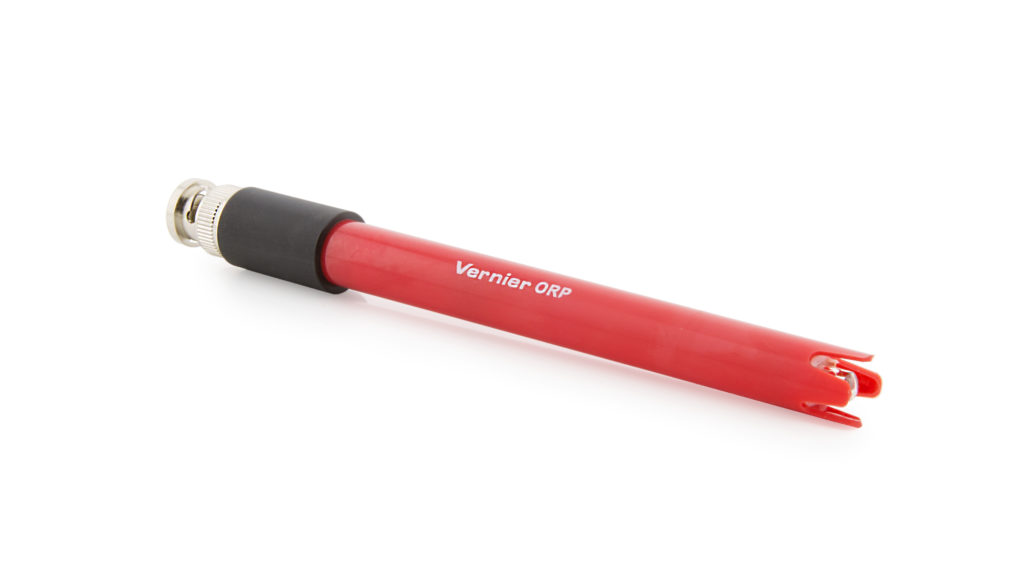Go Direct® ORP BNC Electrode User Manual
Order Code: GDX-ORP-BNC
The Go Direct ORP BNC Electrode is designed to be used with the Vernier Go Direct Electrode Amplifier (order code GDX-EA) to make measurements in the mV range of –1,000 to +1,000. Our Go Direct ORP BNC Electrode can be used to measure the ability of a solution to act as an oxidizing agent and to quantify ion activity. This sensor measures the capacity of a solution to either release or accept electrons from chemical reactions.
Note: Vernier products are designed for educational use. Our products are not designed nor are they recommended for any industrial, medical, or commercial process such as life support, patient diagnosis, control of a manufacturing process, or industrial testing of any kind.
What's Included
- Go Direct ORP BNC Electrode
- Electrode Storage bottle, containing pH 4/KCl solution
Using the Product
To prepare the electrode to make mV measurements, follow this procedure:
- Remove the storage bottle from the electrode by first unscrewing the lid and then removing the bottle and lid. Thoroughly rinse the lower section of the probe, especially around the bulb-shaped tip, using distilled or deionized water.
- Connect the Go Direct ORP BNC Electrode to the Go Direct Electrode Amplifier. Push the BNC connector of the electrode onto the connector on the amplifier, then turn the BNC connector about one-half turn clockwise.
- Connect the amplifier to your computer, Chromebook™, LabQuest®, or mobile device and run the data-collection software. Note: By default, the Electrode Amplifier measures pH. You may need to change the displayed channel to potential (mV), see www.vernier.com/til/3984
When you are finished making measurements, rinse the electrode with distilled water. Slide the cap onto the electrode body. Screw the cap onto the storage bottle so the tip of the electrode is immersed in the storage solution. When the probe is not being stored in the storage bottle, it can be stored for short periods of time (up to 24 hours) in pH 4 or pH 7 buffer solution.
The electrode should never be stored in distilled water. It is a good idea to prepare a quantity of pH 4 buffer/KCl storage solution (see the section on Care and Maintenance) and use it to replace lost solution. Note: Do not completely submerge the sensor. The BNC connection is not waterproof.
Calibrating the Sensor
The Go Direct ORP Sensor cannot be calibrated.
Specifications
|
Range |
–1,000 mV to +1,000 mV |
|
Accuracy with new electrode (mV) |
±20 mV |
|
Type |
Sealed, gel-filled, polycarbonate body, Ag/AgCl reference, single junction |
|
Resolution |
0.01 mV |
|
Storage solution |
pH-4/KCl solution (10 g KCl in 100 mL buffer pH-4 solution) |
|
ORP element |
99% pure platinum band sealed on a glass stem |
|
Impedance |
~20 kΩ at 25ºC |
|
Shaft diameter |
12 mm OD |
Care and Maintenance
Short-term storage (up to 24 hours): Place the electrode in pH 4 or pH 7 buffer solution.
Long-term storage (more than 24 hours): Store the electrode in a pH 4 buffer/KCl storage solution in the storage bottle. The ORP Electrode is shipped in this solution. Vernier sells 500 mL bottles of pH Storage Solution (order code PH-SS), or you can prepare additional storage solution by adding 10 g of solid potassium chloride (KCl) to 100 mL of pH 4 buffer solution. By storing the electrode in this solution, the reference portion of the electrode is kept moist. Keeping the reference junction moist contributes to electrode longevity and retains electrode response time when the unit is placed back into service. If the electrode is inadvertently stored dry, immerse the unit in pH 4 buffer/KCl storage solution for a minimum of eight hours prior to service.
Troubleshooting
When testing a Go Direct ORP BNC Electrode, it is best to measure a standard solution because it is easier to determine if the sensor is reading correctly.
Examine the glass bulb. If it is broken, mV readings will be incorrect.
Residue on the tip of an ORP Electrode can cause the readings to be noisy. To clean the electrode, use a soft cloth to wipe a small amount of ethyl alcohol or isopropyl alcohol around the globe-shaped tip of the probe. Rinse the tip with distilled water, and repeat the alcohol cleaning one more time.
Occasionally, mold will grow in the pH 4 buffer/storage solution. Mold will not harm the electrode and can easily be removed using a mild detergent solution. Mold growth in the storage solution can be inhibited by adding a buffer preservative.
For additional troubleshooting and FAQs, see www.vernier.com/til/3967
Repair Information
If you have followed the troubleshooting steps and are still having trouble with your Go Direct ORP BNC Electrode, contact Vernier Technical Support at support@vernier.com or call 888-837-6437. Support specialists will work with you to determine if the unit needs to be sent in for repair. At that time, a Return Merchandise Authorization (RMA) number will be issued and instructions will be communicated on how to return the unit for repair.
Accessories/Replacements
| Item | Order Code |
|---|---|
|
PH-SS |
|
|
PH-BUFCAP |
|
|
BTL |
Warranty
Warranty information for this product can be found on the Support tab at www.vernier.com/gdx-orp-bnc/#support
General warranty information can be found at www.vernier.com/warranty
Additionally, the warranty does not cover accidental breakage of the glass bulb of the ORP Electrode.
Contact Support
Fill out our online support form or call us toll-free at 1-888-837-6437.

